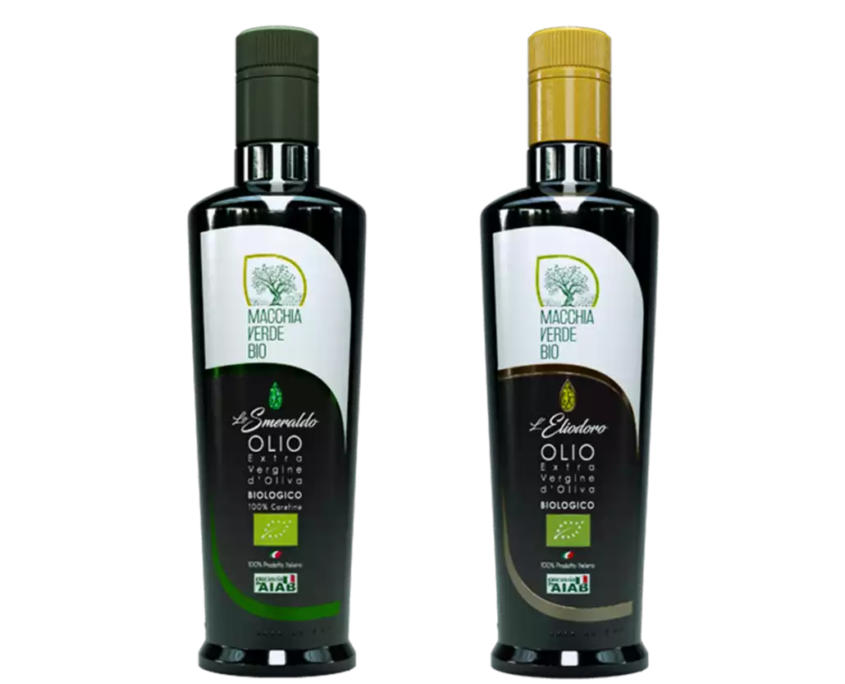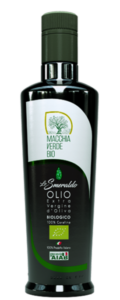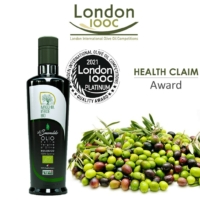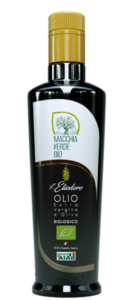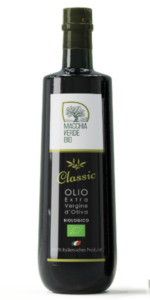EXTRANATIVE BIO OLIVE OIL – Lo SMERALDO
Properties of “The Polyphenol Miracle”
The Smeraldo (The Emerald) is a lush green and full-bodied olive oil of the highest quality, pressed from 100% Coratina olives. It has participated in all national and international competitions year after year and has been awarded a gold medal in the “Fruity” category and a platinum medal at the Health Claim Award in London.
Since only Coratina olives are used, Smeraldo is characterised by its extremely high polyphenol content. It is the high polyphenol content in particular that gives Coratina oil its intense, fruity, fresh taste. The scent of olives is clear and unmistakable, there are distinct notes of raw fruit and hints of fresh green almonds.
The Smeraldo is ideal for pizza and pasta dishes, but also for focaccia, steak and grilled dishes. It is also the ideal olive oil for making grill marinades and pickles, as its maximum amount of polyphenols allows it to be absorbed deep into the meat and to transport the aromas of the herbs.
EXTRANATIVE ORGANIC OLIVE OIL – L’ELIODORO
features
The Eliodoro (The Heliodor) is golden yellow and balanced olive oil of the highest quality, it is obtained 70% from Coratina and 30% from Ogliarola olives. It has participated in all national and international competitions and has been awarded a gold medal in the “Medium Fruity” category.
Adding Ogliarola olives softens the rich notes of the Coratina olive, making this oil a perfect companion for raw food cuisine. The Eliodoro also shines when it comes to polyphenols, although they are about 15% lower than the Smeraldo, but the Eliodoro is on average 20% richer in polyphenols than most oils you find in shops.
Aromatically, Eliodoro opens with a scent of green olives and herbs, clear notes of green apples, fennel, thyme and almonds, with notes of pine nuts in the aftertaste.
The Eliodoro is ideal for salads, antipasti and starters, for making vinaigrettes and mayonnaise. It enhances any fish dish, whether boiled or grilled, and seafood in general. Indispensable for any raw food preparation, as it enhances the absorption of nutrients in terms of flavour and nutrition.
EXTRANATIVE ORGANIC OLIVE OIL – CLASSIC
features
Full of flavour – soft in price
The Classic is a balanced olive oil of high quality, a blend of Coratina and Ogliarola olives. It appears golden yellow with green reflections, is medium-fruity, full-bodied, with notes of almonds and artichokes. It is suitable for a wide range of dishes and could also be called the “everyday olive oil”.
What is the difference between the “Classic” and the award-winning oils? The only difference between the “Classic” and the “Smeraldo” and “Eliodoro” is the harvest time. While the harvesting of the other two oils takes place at a very early stage, the olives for the Classic are not harvested until the production of the first two has been completed. The olives for the Classic are then fully ripe at the time of harvesting. The olives are harvested with hydraulic vibrators and processed within 24 hours, with attention to all the small details that only manual processing makes possible. Filtering is done by decantation to preserve the structure of the micro- and macromolecules in the fully ripe oil. Due to the characteristics of the Coratina olives, “Classic” also retains a rich treasure of polyphenols (almost 400 mg/kg) and thus outperforms all olive oils in the same price range.
About polyphenols
What they are and what they do?
Many secondary plant substances are summarised under the term polyphenols.
These include substances such as flavonoids, anthocyanins, procyanidins (OPC), vanillic acid, caffeic acid, coumaric acid, oleuropein and resveratrol, which is held responsible for the health benefits of red wine. The content of phenolic compounds in olive oil depends on the degree of ripeness and freshness of the olives, as well as the care taken to produce the oil. As the olives ripen, both polyphenols and tocopherols decrease. Most phenolic compounds are found in the olive leaves.
Polyphenols have antioxidant, anti-inflammatory and anti-carcinogenic effects and protect the heart. It has been proven at the University of Cordoba that only oils with a high polyphenol content have their full effect. Extra-virgin olive oil contains about 10 times more polyphenols than refined olive oil. High-quality olive oil contains 200 – 1,000 mg of polyphenols per kg. The EU allows the expression “olive oil polyphenols help protect blood lipids from oxidative stress” for olive oils containing at least 5 mg of hydroxytyrosol and its derivatives (e.g. oleuropein complex and tyrosol) per 20 g.
1. Oleuropein
Oleuropein is the most common polyphenol found in olives. In a 2014 Italian summary study, the authors were able to show that oleuropein has antioxidant, anti-inflammatory, anticarcinogenic, liver-protective, antiviral, antibacterial and neuroprotective properties.
2. Oleocanthal
This phenolic compound is anti-inflammatory and has surprisingly the same mechanism of action as ibuprofen. The discovery was more of a coincidence when scientist Gary Beauchamp found that olive oil caused the same scratchy throat as the drug. Oleocanthal also has anti-cancer properties and is thought to reduce the risk of developing Alzheimer’s disease.
3. Hydroxytyrosol
This plant substance, which also belongs to the phenols, also has antioxidant properties. The EFSA scientific committee – the EU’s food safety authority – considers hydroxytyrosol to be one of those polyphenols that prevent the oxidation of blood lipids.
Sterols
Sterols are an important component of the cell membrane. Cholesterin is an animal sterol. The phytosterols in olive oil lower LDL cholesterol by inhibiting the absorption of cholesterol in the intestines.
Triterpenes
Triterpenes are resinous substances related to essential oils. They have antioxidant, anti-inflammatory, antitumoral, antibacterial and antiviral effects.
Squalene
Squalene belongs to the group of triterpenes. It is widespread in nature and is also found in humans as an essential component of skin lipids. Olive oil contains approximately 4,000 mg squalene/kg. It is often used as a humectant in cosmetics.
Extranative of native extra …
… of the lax handling of a quality seal.
Be careful not to confuse “extra virgin olive oil” with “quality oil”.
The European olive oil regulation is intended to give the olive oil trade a legally binding framework and to set minimum quality standards. However, the minimum requirements have been lowered to such an extent that there is hardly any oil that does not meet them. Under the law, cunning producers could – legally – mix oils to such an extent that they meet the limits of the ‘extra virgin’ quality class.
There is a lot of cheating going on within the framework of the legal possibilities. Olive oil is sometimes traded and treated several times before ending up in the bottle (the skilled chemists of the big companies are good at this) and then mixed again. This oil does not make you sick straight away, of course, but it is mainly consumer fraud.
It is easy to understand that “extra virgin olive oil”, which is sold in the supermarket for 3-4 € per bottle, is certainly not one of the “good oils” and absolutely not comparable with them in terms of health effects and taste. Especially when you consider that the production cost for one litre of high-quality olive oil – depending on the location of the olive groves – is at least € 6, but usually well over € 10.
OLIVE OIL & FITNESS
How does a good olive oil for exercise and muscle building work?
Top athletes have known for years that high-quality extra virgin olive oil benefits their performance. Initially, it was only used to consume healthy, easily digestible calories. Extra virgin olive oil is becoming increasingly popular in fitness clubs, not least because of its easy digestibility. It has recently become common knowledge that extra virgin olive oil is full of antioxidants like oleacein and anti-inflammatory agents like oleocanthal that help us build muscle, heal or prevent injuries, and regenerate muscle. This works best only with an extra virgin olive oil with a high polyphenol content.
There are other benefits from the polyphenols found in high quality extra virgin olive oil, which includes anti-inflammatory ingredients such as oleocanthal, a tyrosol derivative. Coratina olive oil has the highest content of these anti-inflammatory phenolic components and contains oleacein, a hydroxytyrosol derivative with a strong detoxifying effect. Vitamin E is another important component found in abundance in extra virgin olive oil, the health benefits of which have long been known.
Monounsaturated fatty acids, oleocanthal, oleacein, vitamin E and numerous other components in olive oil form the basis for the superfood extra virgin olive oil. Many sports websites refer to the information quoted by nutritionist Dr. Douglas Kalman of Florida International University: “The monounsaturated fat in olive oil appears to act as an anti-catabolic nutrient. In other words, it prevents muscle breakdown because it lowers levels of the harmful cellular protein TNF (Tumour Nectrosis Factor-a), which has been linked to muscle breakdown and muscle weakness.”
TNF has even been linked to inflammation. It turns out that EVOO does not increase it like other lipids, but it is believed to be involved in reducing TNF. Because of its anti-inflammatory effect, extra virgin olive oil supports muscle building. This is the most important factor in building muscle mass. It is not really surprising that bodybuilders make extra virgin olive oil an essential part of their diet.
“MILD” olive oil is not a good thing…
Even if it sounds strange at first:
Bitter is better!
And sharpness too. Both tastes are typical of fresh, high-quality olive oil; they are caused by the polyphenols present, antioxidants that are abundant in a good oil. In ours to a maximum extent. So don’t be fooled by a promise of leniency about olive oil, a good olive oil tastes strong and fresh. It is also a little bitter and often has a spiciness to it. It even scratches the throat – that is a quality characteristic. The colour does not matter. So how is a mild olive oil made? There are olive oils that are naturally milder, depending on the type of olive and the growing region. This is how it is, for example. In the case of olive oil from northern Italy, from the growing areas in Liguria or on Lake Garda, it is particularly “mild” because of its low polyphenol and oleic acid content (i.e. the components that make olive oil so healthy), but production there is even more complex than elsewhere and correspondingly expensive! There are, however, other reasons for a particularly mild oil:
- it was badly processed and is therefore too rich in free oleic acids
- it may be simply old and oxidised
- it may be very old and chemically treated, i.e. deodorised lampante oil.
- it is not olive oil at all, but for example. Soybean oil or something similar. with additives.
- Get confused if the above criteria are not met and if the litre of oil costs less than the oilman needs to produce it – at least 6 euros!

